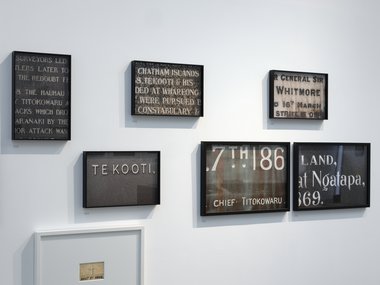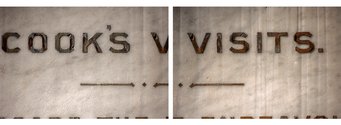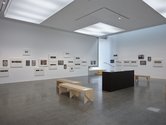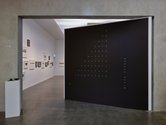John Hurrell – 11 February, 2021
The fragments reference friend and foe, victim and perpetrator, ally and nemesis. And with the carved language, its politics is usually overt (but not always), assuming an indignant pākehā colonial/settler readership. (A good example is…'law and order against fanaticism and barbarism' from Moutoa, Whanganui.) Sometimes in this Vocabulary Connew counter-charges by butting words from different images together—such as ‘tragically' and ‘slaughter'—or showcasing ‘punitive of the crown, confiscation': all three from a memorial at Te Tarata pā, Waioeka.
Titirangi
Bruce Connew photographs (with sections of He Mōteatea & an essay by Rangihīroa Panoho)
A Vocabulary
5 December 2020 - 14 February 2021
Designed to promote the stunning Biblelike book of Connew photographs and Panoho texts—created mostly to focus on the Te Ika-a-Māui North Island memorials, pou whakamaumahara and gravestones of key personalities killed in the Land Wars—this very moving exhibition presents (on the walls) a selection of the published images. A selection of Panoho’s commentaries (10 excerpts and an intro) can be read in a centrally positioned vitrine.
Of the 306 photographs in the book/published artwork, 79 are here. Almost all depict fragments of carved text on headstones and memorials (mostly English), and some pairs of images overlap. Connew has cropped these very carefully to create a sort of stuttering collective poem (scattered pieces linked by ellipses) mocking Imperialist sensibilities (when they surface) and saluting the fallen of both sides—as your eye moves back and forth taking in the carefully positioned images.
The subtly coloured mottled photographs are quite beautiful, and there is a free, narrow, twelve-page, paper catalogue containing extensive info on each historical event behind each image, naming personages and sites.
Some of these documented quotations present combatants’ names (dead and—at the time—living); place names where events occurred; isolated parts of speech vital to Connew’s aims, like the conjunction ‘and’ or adverb ‘also’ used to account for tragedies on both sides; pertinent dates; military ranks; political positions; descriptions of military fortifications; or textual slices of violent conflictual narrative. Sometimes we see only fragments of words.
When perusing the walls, it is hoped you will recognise the historical significance of certain names, places or dates, look up the image number in the catalogue and read the very informative but brief account provided, and perhaps look further afield in a reliable online source like Te Ara: the Encyclopedia of New Zealand.
Significant protagonists (mentioned by name) in these photographed quotations include: Capt. James Cook, Queen Victoria, Rev. William Colenso, Edward Gibbon Wakefield, Arthur Wakefield, William Hobson, Rev. Henry Williams, Te Rauparaha, Hōne Heke Pōkai, Sir George Grey, Sir William Fox, Potatau Te Wherowhero (First Māori King), Tawhiao (Second Māori King), Te Kooti Arikirangi Te Turuki, Capt. Gilbert Mair, Col. Thomas McDonnell, Gustavus von Tempsky, General Duncan Cameron, Te Keepa Te Rangihiwinui, Rev. Carl Volkner, Wiremu Tamehana Tarapipipi Te Waharua, Henry Crann, Te Wetini Taiporutu, Hēmi Taiporutu, Titokowaru, Ropata Wahawaha, Rewi Manga Maniapoto, Col. Marmaduke Nixon.
The fragments reference friend and foe, victim and perpetrator, ally and nemesis. And with the carved language, its politics is usually overt (but not always), assuming an indignant pākehā colonial/settler readership. (A good example is…’law and order against fanaticism and barbarism’ from Moutoa, Whanganui.) Sometimes in this Vocabulary Connew counter-charges by butting words from different images together—such as ‘tragically’ and ‘slaughter’—or showcasing ‘punitive of the crown, confiscation’: all three from a memorial at Te Tarata pā, Waioeka.
In the central vitrine, Panoho presents ten excerpts from his lament and essay, the discussions (quoting politicians like Shane Jones) stressing that dissent is vital for a healthy democracy, that te kōrero must continue, and that the wars focussed on here are—in essence—not yet over. Fundamental issues are not yet resolved.
John Hurrell





 Advertising in this column
Advertising in this column Two Rooms presents a program of residencies and projects
Two Rooms presents a program of residencies and projects



This Discussion has 0 comments.
Comment
Participate
Register to Participate.
Sign in
Sign in to an existing account.